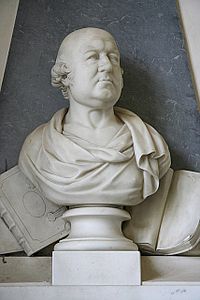|
Francis Willis (physician)
 Francis Willis (17 August 1718 – 5 December 1807) was an English physician and clergyman best known for his treatment of George III and Maria I of Portugal.[1][2] Early careerWillis was the third son of the Rev. John Willis of Lincoln. He claimed to be a descendant of the Willis family of Fenny Compton, Warwickshire, a kinsman of the George Wyllys who became Governor of Connecticut, New England, and the Willis baronets of Fen Ditton, Cambridgeshire. After an undergraduate career at Lincoln College, Oxford and St Alban Hall he was elected a Fellow of Brasenose College, Oxford in 1740 and was ordained as a priest.[3] Willis was Rector of the college living of Wapping 1748–1750. He resigned his Fellowship in 1750, as he was required to do on his marriage, and he and his wife took up residence at Dunston, Lincolnshire, where he looked after the local interests of Sir Francis Dashwood whilst apparently practising medicine.[4][5] In 1755 he published 'The Case of a Shepherd near Lincoln' in the London Gazette,[6] and in 1760 'An account of an extraordinary Case of a Lady who Swallowed Euphorbium'.[7] Willis the physicianAlthough Willis was ordained in accordance with his father's wishes, his chief interest was in medicine and he received the degrees of Bachelor and Doctor of Medicine from Oxford in 1759 before serving as a hospital physician in Lincoln, where his early successes with the mentally ill, or "wrongheads" as they were commonly known at the time, led to him treating such patients in his own home:
In 1776, Willis moved to Greatford Hall, near Bourne, Lincolnshire, which he developed as a private rural sanitorium. As part of the treatments his patients were encouraged to perform manual work in and around the stables and fields of the Greatford estate, the fresh air and exercise likely contributing to their recovery. On visiting the estate in 1796, Frederick Reynolds recorded:[9]
FamilyDr Willis married Mary Curtois and their children included Rear Admiral Richard Willis. Treating the KingGeorge III had his first attack of madness, possibly attributable to porphyria, which could have been triggered by an excess of rich wines, or more likely an over exposure to the arsenic related to the elaborate hats commonly worn in the Georgian period (though this diagnosis has been challenged, with various other causes being put forward, such as bipolar disorder).[10] The court physicians were baffled by the symptoms and failed to treat the King successfully. In 1788 Willis was recommended to the increasingly concerned Queen Consort by an equerry's wife, whose mother Willis had treated successfully.[11] Willis's treatment of the King at The White House, Kew, included many of the standard methods of the period, including coercion, restraint in a strait jacket and blistering of the skin, but there was also more kindness and consideration for the patient than was then the norm. When on 26 February 1789 Willis's bulletin described the "entire cessation of his Majesty's illness" he became a British celebrity and was soon recognised through five portraits by John Russell, one of the most renowned portrait painters of the day. Willis commissioned a special medal to commemorate his own achievements. The Reverend Doctor Francis Willis was rewarded by the King with £1,500 a year for 21 years and assistant and son Dr John Willis with £650 a year for the rest of his life.[12] The King's recovery made Willis's national reputation and he had to open a second establishment at nearby Shillingthorpe Hall (in the parish of Braceborough) to accommodate the numbers of patients seeking his help. Shillingthorpe Hall was demolished in 1949.  Twelve years later in 1801 King George suffered a relapse and his symptoms returned. On the second occasion he was treated by two of Francis's sons, also physicians, John Willis and his younger brother, Robert Darling Willis. The King had a final relapse in 1810 that proved incurable and he lapsed into an illness and madness that lasted until his death in 1820. Treating Queen Maria I of PortugalWillis' fame would lead him to help Queen Maria I of Portugal in 1792 who suffered from episodes of madness. His role was advisory and did not see success as in the case of King George III. His recommendations included psychotherapy and proper nutrition as opposed to medication.[2] The job earned him a total of £16,000.[13] LegacyThe original Greatford Hall sanatorium closed in 1838 and was mostly destroyed by fire in 1930, but was mostly rebuilt and is now a private residence. There is a monument to Dr Willis in the form of a Joseph Nollekens bust, in the transept of his local Church of Thomas Becket in Greatford. The commemorative inscription reads:
Lincolnshire Partnership NHS Foundation Trust's inpatient low secure unit is the Francis Willis Unit. It 'provides assessment and treatment for males aged 18 to 65 years with a primary diagnosis of mental illness who may exhibit challenging or high risk behaviours... We aim to promote recovery and rehabilitation, enable the reduction of risks posed and ultimately enable the individual to leave the secure environment for one less restrictive.' References in literatureWillis's reputation was revived by Alan Bennett's play The Madness of George III, and its later film adaptation, The Madness of King George with a sympathetic portrayal by actor Ian Holm. The Willises are portrayed as the callous jailers of Windsor Castle in Susanna Clarke's novel Jonathan Strange & Mr Norrell, under the impression that visitors, exercise, or other distractions would provoke hysteria in King George III. He is also referenced by Stephen Maturin in Patrick O'Brian's novel The Thirteen-Gun Salute.[citation needed] References
External links |
||||||||||||||
